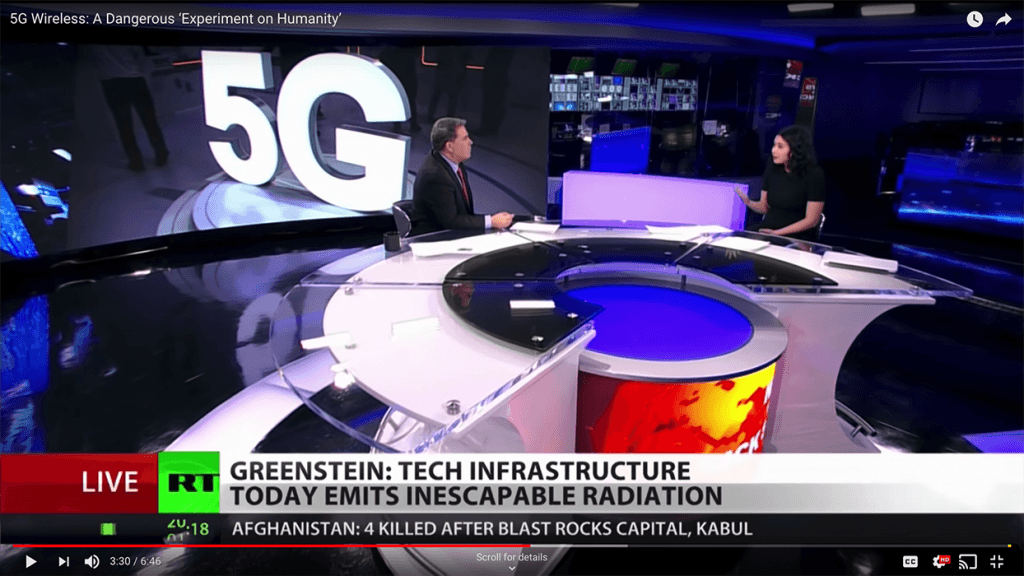By Matt Field
 “All of our digital tech sends this data back and forth using these invisible microwave radiation signals, aka radiofrequency radiation,” Michele Greenstein, an RT America correspondent, told her viewers. “That’s today’s tech. We have every cell tower, every router, constantly pulsing with radiation, whether or not you’re using it.”
“All of our digital tech sends this data back and forth using these invisible microwave radiation signals, aka radiofrequency radiation,” Michele Greenstein, an RT America correspondent, told her viewers. “That’s today’s tech. We have every cell tower, every router, constantly pulsing with radiation, whether or not you’re using it.”
Greenstein was in the studio for another of RT America’s signature hits on 5G technology, the next generation of cellular data transmission being rolled out in the United States and elsewhere. “I’m saying there should at least be a public debate about the health effects.”
Greenstein’s network, it turns out, is one of the main voices calling for that debate, according to a recent report in The New York Times. And for a network funded by the Russian government, it’s also a call that’s strikingly at odds with Russian President Vladimir Putin’s own views. The Times notes that Putin is a strong promoter of 5G, which is short for fifth generation. In a recent speech, Putin outlined his plans for a 5G network. “We need to look forward. The challenge for the upcoming years is to organize universal access to high-speed Internet, to start operation of the fifth-generation communication systems.”
So what gives?
The new high-speed networks have become a flash point in global geostrategic competition, most notably between the United States and China. The US government has tried to persuade other countries to bar Chinese firm Huaweifrom developing their networks, fearing it could provide a toehold from which Beijing could spy or disrupt infrastructure. Ryan Fox, an official with New Knowledge, a tech firm that tracks disinformation, told the Times that RTAmerica’s attack on 5G was economic warfare: “Russia doesn’t have a good 5G play, so it tries to undermine and discredit ours.”
RT America, a subsidiary of RT, often focuses on polarizing issues that aren’t necessarily top-of-mind for viewers, applying high-quality graphics and production values to its stories. After watching RT, Guardian reporter Tim Dowling once wrote, “Fringe opinion takes center stage. Reporting is routinely bolstered by testimony from experts you have never heard of, representing institutions you have never heard of.”
And while that reporting likely doesn’t reach the TV audience RT claims, there’s no question about its online reach. A 2017 report by the US Director of National Intelligence said that since 2005, RT has averaged 1 million YouTube hits a day. The intelligence services concluded that RT played a role in Russia’s disinformation campaign against the 2016 US presidential election, calling the network, the Times noted, the “Kremlin’s principal international propaganda outlet.”
The World Health Organization (WHO) says a lot of research is focused on the potential health risks posed by cell phone use. When it comes to exposure to the radiofrequency electromagnetic fields (EMFs) emitted by cell phones, the the organization says it’s found “no obvious adverse effect of exposure to low-level” fields. There are some epidemiological studies that point to a possible connection between EMF exposure and some cancers, including, for example, what might be a slightly increased childhood leukemia risk. But the results of research in this area are tenuous. The US National Cancer Institute puts the situation this way: “No consistent evidence for an association between any source of non-ionizing EMF and cancer has been found.”
“It is clear that if electromagnetic fields do have an effect on cancer, then any increase in risk will be extremely small,” the WHO says.
While the WHO leaves the door cracked open to the possibility that EMF exposure can increase the risk of getting cancer in some cases, RT Americaflings it wide open. According to the Times report, the network cherry-picks explosive claims about 5G and gives “marginal opponents of wireless technology a conspicuous new forum.”
No comments:
Post a Comment